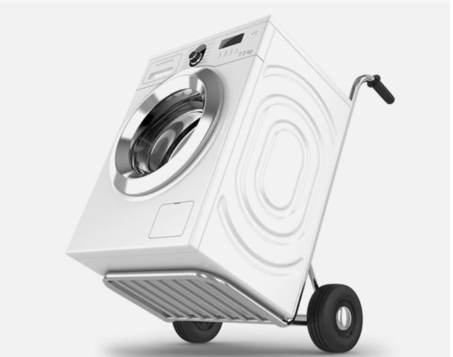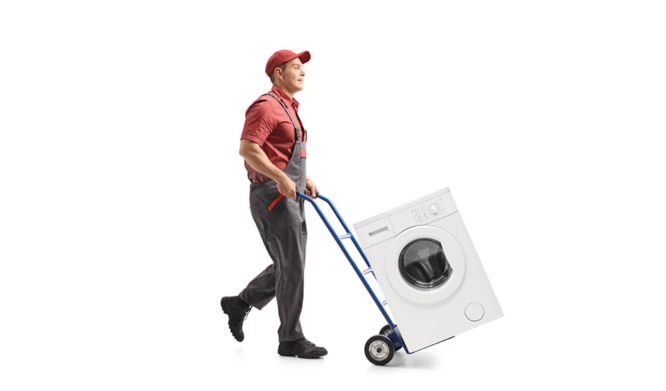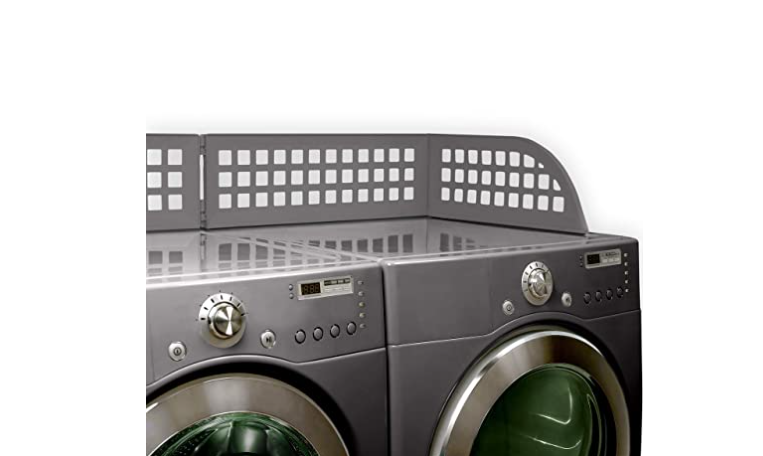Moving a washer can be a complex operation. They are hefty, making moving a washer without breaking it challenging. Can you lay a washing machine on its side? A used washing machine should never be moved. If you transfer it, the manufacturer’s guarantee will no longer be valid, and there are hazards involved. A washing machine can, however, be placed momentarily on its side. For instance, you may clean behind it or reach the water hoses without moving them.
To Relocate A Washing Machine, What Do You Need?

Whether your washing machine is a front-loading model or a top-loading one won’t matter; you’ll still need to follow a few essential, universal procedures to relocating a washer if you want to call the entire appliance moving process a success. Before relocating a washing machine from one home to another, follow these steps:
1 – Purchase a Furniture Caster
Use a moving dolly from your neighborhood moving business for simple and secure transportation. If you’re still unsure whether you can move a washing machine by yourself without that tool, you shouldn’t hesitate. The moving dolly will also be a valuable helper when moving other heavy and oversized household items like your furniture, refrigerator, dishwasher, electric stove, etc.
2 – Prepare Some Furniture Coverings
When your washing machine is properly prepared for shipment, you must safeguard it from roadside collisions and damages. The most satisfactory protection for your washer will come from professional furniture coverings, but regular home blankets or sizable sheets of bubble wrap can also work well.
3 – Locate the Instruction Book
Consult the manufacturer for advice on how to move a washing machine securely. The user guide for the electric appliance should be somewhere among the purchase records, such as the invoice and warranty if you purchased it brand-new. That user guide might not have ever been in your possession if you purchased your washer used.
Search online for the owner’s manual for your specific washer model by entering the brand, model, and the word “manual” in the search box. Call the shop where you purchased the washer and ask them for help if you are still unable to locate it.
If your washing machine‘s maker has offered specific advice on how to get your washer ready to move, heed them. If not, following our general moving advice for washing machines should ensure that nothing untoward occurs to your dependable device.
4 – Find the Transit Bolts Beforehand
Washer locks that secure the drum and shield it from damaging road vibrations are always included with washing machines. If you purchased your front-load washer brand-new, the transit bolts should be someplace in your home. Front-load washing machines typically have shipment bolts inserted at the appliance’s rear.
Ideally, you’ll know exactly where they are. If not, check with the household appliances retailer to see if they have the necessary bolts for your model.
How Should A Washing Machine Be Set Up?
Knowing a washing machine may be positioned on its side. You can save a lot of money and a ton of frustration by researching whether or can you lay a washing machine on its side? As a final option, turn the COMFEE’ 2.0 Cu.ft washing machine on its side and proceed as directed.
You may look up the cost of this incredible COMFEE’ 2.0 Cu.ft washing machine on Amazon.
The washing machine will be correctly packaged in its original container before being transported, with foam or foam in the wall, but this is preferable. Most frequently, a washing machine that has been in use for more than a year still retains any remaining parts and fasteners in addition to the packaging. You will therefore need to improvise while traveling. You must first perform the following to prepare the washing machine for shipping.
- Disconnect the washing machine from the plumbing and electrical systems. This may seem absurd at first, but there are a lot of instances where the machine is relocated without first disconnecting the hoses or even just one of the hoses. Frequently, people fail to cut the power cord.
- The machine’s leftover water should be drained. Water can become stagnant in hoses, pipelines, drain pumps, and cause issues while moving a home appliance.
- Fix the sunroof, hoses, and cables, so they don’t hang out and get in the way when moving the washing machine.
- To protect people from harm when hauling the washing machine, tape all sharp edges and project sharp pieces.
After that, you must take action to fix the washing machine’s tank. Shipping bolts, which are screwed through the holes in the washing machine’s back, are the best fastening choice. You may learn more about installing and removing shipping bolts in this post. If the transport bolts are not preserved, you will need to remove a few bolts to open the washing machine’s upper wall, and you will then need to fill the area between the tank and the walls with foam rubber polystyrene, clean rags, and the like. The top wall must then be fastened back together using the fasteners.
Wrap the washing machine body in a cloth and secure it with twine after the tank has been repaired. You can effectively transfer the computer without the original packing if following the steps above, but you must be careful.
Your Front-Load Washer Must Be Moved
You may look up the cost of this incredible Haus Maus front-loading washer on Amazon.
We’ll demonstrate various original ways for you to set your front-loading washing machine, such as the Haus Maus Front Loading Washing Machine, on its side in this article. This makes it possible to position it in a unique location like a closet or another out-of-the-way area of the house. Although these suggestions are aimed toward persons with little space, practically any household might utilize them. To get more about can you lay a washing machine on its side, continue reading. How and where should your washer be installed?
Moving a washer in an upright position is the safest method. A dolly is suggested to lift your washing machine off the ground and through any impediments, whether a flight of steps or up into a truck, due to most washing machines’ height and unusual design. To be safe, tape down any latches and doors and secure your machine to the dolly with bungee cords or a sturdy rope. To avoid potential dents, dings, or scratches during transport, keep your washing machine wrapped in blankets in the back of a truck when it’s time to load it into your moving vehicle.
What to Avoid?
Although washing machines may appear prominent and cumbersome, their inner workings are relatively delicate and can readily upset if not handled carefully. When you turn your washer on its side, you risk banging the inner and outer tubs together, which could result in problems like loose pads, a broken suspension, or the out of alignment of your washer. Attempting to move a washing machine on its back might cause similar problems. Thus it is not advised that you do either when moving a washer.
What Occurs When A Washer Is Placed On Its Side?
If you keep a washer on its side, several things can occur. The glass doors and bathtubs might be broken, among other things. The damage may be significantly more significant if you put those appliances on their side when transferring them carelessly. Examine-in detail what would occur if you lay a washer on its side:
1 – Tubs May Shift Out Of Position
Two tubs are a feature of the washers, and they are mounted to stay in place even when the machine is upright. Due to the lack of a protective coating on their sides, the tubs do not stay in place when the washer is maintained on its side.
The washer may become faulty due to the tubs shifting out of alignment, or they may even suffer irreversible harm.
2 – Suspension-Related Harm
The washer’s suspension system is designed to hold the tubs in place throughout any movement while upright. When you put the washer on its side, pressure will drop on the suspension’s side, causing it to flex and sustain damage.
3 – Support Pads May Come Undone
The support pads are fastened when the washer is left in its regular position. The support pads will move more than usual and may become loose if the washer is stored on its side.
How Should A Washing Machine Be Prepared For A Move?
You must unplug a washing machine and secure the power cord before transferring the appliance. The washer’s body and the glass door may be harmed if the cord is not secured. The washer should then be empty before you begin packing it. After completing all of that, you should secure the entire washing machine by wrapping it in cushioning and bubble wrap.
Can I Leave Things in the Drawers of My Dresser?
Leave your clothing in your dresser drawers. Can you lay a washing machine on its side? If you’re doing a DIY move, rather than waste time and effort taking everything out of the drawers and storing it in different boxes or bags. When you unload a dresser, you are essentially packing “air” when you might be packing clothes and other soft objects instead, which take up more room in your moving truck outside the dresser than inside. However, never transfer breakables within dresser drawers even when they are covered.
Additionally, confirm with the expert movers you plan to hire first. When storing your belongings for an extended period, some businesses won’t permit anything to be kept in your drawers. When moving items inside your dressers, firmly secure the drawers to prevent the contents from opening and spilling.
Conclusion
Not all houses are created equal when it comes to laundry. It may seem impossible to install new appliances or upgrade old ones if you live in a tiny space. Can you lay a washing machine on its side, you might be asking. There is another approach solve addressing the problem besides using laundry. You can keep doing your laundry at home if you reevaluate how you use your washing machine and figure out how to fit it into your available space.
Frequently Asked Questions
Can I transport a washer in my car?
A: A washing machine should be transported in its normal posture; it shouldn’t be set on its side. It won’t be able to fit a washer upright in the trunk of a typical car. Therefore, a washing machine cannot be moved in a vehicle. But you can move it about very nicely in a pickup truck.
How should a washing machine be moved?
A: When moving your washing machine, following the manufacturer’s recommendations is crucial. If the washer is not moved correctly, it could suffer significant damage and require repairs. When moving the washer, use two people. Use a hand truck made for moving appliances to move your washing machine. To protect you, the washer, and the flooring you are traveling on, try to utilize a ramp wherever possible.
A washing machine move without professional movers
A: It’s time to start relocating your washing machine now that everything is prepared to go! To ensure that nothing goes wrong during the move, follow these instructions thoroughly.


